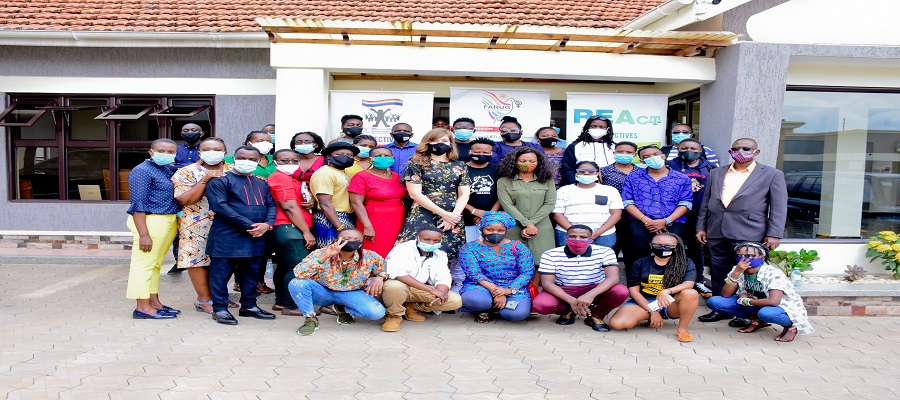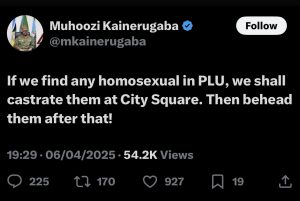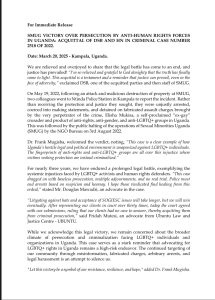Sexual Minorities Uganda (SMUG) together with Freedom and Roam Uganda (FARUG) and Tanja Dittfeld, a doctoral researcher from the University of Sydney in Australia organized an exhibition dubbed Photovoice on Friday 14th August 2020.
Photovoice took place at the SMUG premises in Kampala under the theme "Wetegeleze" which is a Luganda word directly translated to mean observe. The event was attended by both FARUG and SMUG staff, allies, representatives from different LGBTI+ community based organizations and dignitaries including Danish Ambassador- His Excellency Nicolaj Hejberg Pedersen who was the chief guest.
SMUG’s Programs Director Pepe Julian Onziema also revealed that they planned on having more similar events and to invite other participants to take part.
Kuchu Times spoke to SMUG's Communications Officer, Phyllis Wanjiru and Tanja Dittfeld about the Wetegeleze Photovoice exhibition and future prospects for the project.
What inspired the theme Wetegeleze for the photovoice exhibition?
TANJA: Photovoice is a participatory qualitative method that not only enables people to identify, represent and enhance their community but also holds the potential to challenge prevailing representations, promote dialogue, and contribute to social change. I initiated and coordinated the Photovoice project with SMUG and FARUG.
I chose Photovoice as the main method for my research to counteract the de-historization of LGBTIQ+ peoples and activism in Africa by both Western and African political and religious leaders; the invisibilisation of LGBTIQ+ peoples and activism in Africa in social sciences, particularly in social movement scholarship; and the universalization of Eurocentric norms for LGBTIQ+ people and activism.
Photovoice in other words recognizes that people have expertise and insight in their own lives and communities that professionals or ‘outsiders’ often lack. While leading the process, I wanted to create a platform for LGBTIQ+ activists in Uganda to record and reflect their community's strengths and concerns instead of mine as an outsider. The name ‘Wetegeleze’ was proposed and chosen by FARUG and SMUG during the joint orientation to localise the Photovoice project and to signal the need to look beyond the prevalent misrepresentation of LGBTIQ+ peoples in Uganda.
What was the importance of the Wetegeleze Photovoice exhibition?
PHYLLIS: We wanted LGBTI+ community members to see and learn how photos can be used for advocacy especially during this Covid19 period.
What was your biggest challenge in preparation of this event?
TANJA: As the Photovoice process commenced at the end of March, COVID-19 disrupted the participants’ possibilities for taking photos beyond their immediate environment. Due to the work from home guidelines, the participants could, for example, not take photos in or around the office. The lockdown not only limited the participants’ geographical range for the photos but also made it difficult to plan the exhibition itself as guidelines for gatherings, social distancing and so forth kept changing, often from one day to another. Another challenge was correspondingly organising the exhibition in a manner that brought together the LGBTIQ+ community, partners and allies, while also adhering to COVID-19 guidelines and, as always, considering the imminent security threats to LGBTIQ+ community gatherings.
What successes has this project registered?
TANJA: : Having 11 participants commit to and follow through on the project during COVID-19 is in itself a success. Then having the LGBTIQ+ community, partners and allies coming together for the exhibition and community forum, despite the lingering threat of COVID-19 is another. The main success is however that Photovoice amplified the visibility and voice of LGBTIQ+ people for and by LGBTIQ+ people.
What does SMUG and FARUG hope to achieve with this initiative?
PHYLLIS: We hope to use the project to fundraise for more projects
Tell us a little about the exhibition event?
TANJA: Selected invitees were first welcomed by the Executive Director of FARUG, Joanita Warry Ssenfuka, the Executive Director of SMUG, Frank Mugisha, and myself. The guests were then taken on smaller guided tours through the three sections of the exhibition, led by staff from FARUG and SMUG. Once the tour was complete, the guests were taken to a community forum where they could learn more about FARUG and SMUG’s work and research As well as view and purchase crafts and products from community members.
Once all the three tours were complete, two reports were launched – one on the impact of COVID-19 on SMUG’s member organisations and one on the impact of COVID-19 on the LGBTIQ+ community.
Any future plans for this project?
Phyllis: Definitely, we have plans for future exhibitions. This was simply a launch. We shall communicate when we're ready for the next exhibition.




